When I was growing up in the suburbs outside of New York, what I knew about Texas would just about have fit on a pin head. Under the age of ten, I could probably sing ‘She’s the Yellow Rose of Texas’ and ‘Deep in the Heart of Texas,’ having some vague idea that Texas was called ‘The Lone Star State.’ Aside from that, I knew it was somewhere ‘out there’ in the middle of the country, was the largest state in the union as was then, and that, for some reason, everything in Texas was big. The mind boggled. Around the age of ten I learned there was something called The Texas Rangers but had no idea who they were, and also that 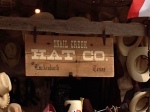 all the men wore cowboy hats. I was aware that Texas was the center of the American oil industry, and that there was a family named King who owned the largest ranch in the United States. And then there was Davy Crockett, Jim Bowie and The Alamo, and eventually Willie Nelson and Waylon Jennings singing about Luckenbach, Texas
all the men wore cowboy hats. I was aware that Texas was the center of the American oil industry, and that there was a family named King who owned the largest ranch in the United States. And then there was Davy Crockett, Jim Bowie and The Alamo, and eventually Willie Nelson and Waylon Jennings singing about Luckenbach, Texas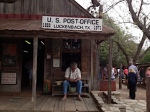 —wherever that might be. Oh, and bluebonnets grow there.
—wherever that might be. Oh, and bluebonnets grow there.
There’s no rhyme or reason to why certain facts filter through, whatever the truth behind them, and others do not, and I have no real idea when the true facts about Texas started to fall into place. In school, history is a general sweep of The United States and perhaps a touch on your home state. My first trip to Texas was when I was aged fifteen with a bunch of fellow high school kids, most of them older than I who had skipped a grade, all bound for college the following year. The trip included El Paso and Houston, and I recall the boys were all terribly…well…naughty, for want of a better word. After that, there were brief visits from London to Dallas, en route to a ranch in Tucson, and a visit to friends living in Richardson, TX. The one memory I have about that stay is being put in a chokehold by a woman in a department store trying to sell me cosmetics.
However, Texas retained its exotic status in my brain despite these unfortunate interludes. I knew Dallas and Houston were hardly representative of a state that could swallow a huge chunk of Europe, never mind several east coast states. The 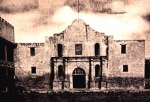 Alamo was a symbol of fortitude and courage; not only had Crockett and Bowie made their mark but elsewhere Sam Houston and Stephen Austin were helping to shape what would become the twenty-eighth state. But there was no historical reason why I would choose Texas as the main setting for my contemporary novel; I was entranced by the Texas Two-Step, and ideas sprang from that. In beginning to write, research, as it often does, uncovered new facts, some of which, I dare say, even Texans may not be aware of. Here are some interesting facts related to Texas I uncovered:
Alamo was a symbol of fortitude and courage; not only had Crockett and Bowie made their mark but elsewhere Sam Houston and Stephen Austin were helping to shape what would become the twenty-eighth state. But there was no historical reason why I would choose Texas as the main setting for my contemporary novel; I was entranced by the Texas Two-Step, and ideas sprang from that. In beginning to write, research, as it often does, uncovered new facts, some of which, I dare say, even Texans may not be aware of. Here are some interesting facts related to Texas I uncovered:
- Alexander Hamilton, a Founding Father, drew up a plan to take over Mexico, which, of course, would have included the area known as Texas. Then-President John Adams nixed the plan. It wasn’t until 1846 that Texas was finally admitted to the Union—a full ten years after gaining independence from Mexico.
- Karl Marx and Frederich Engels believed that all of Mexico, then including Texas, should be placed in the hands of the United States. After Texas won independence from Mexico, the very diplomatic President Martin Van Buren (President 1837-1841) decided on Texas remaining autonomous, which it did from 1836-1846. It was President Polk ( President 1845-1849) who agreed to admit Texas to the Union.
- The boundaries of Texas originally included half of what is today New Mexico, about a third of present Colorado, plus bits of Kansas, Oklahoma and Wyoming. The extra bits were given up in exchange for the US Federal Government assuming Texas’ debts.
- Galveston, the major port of Texas, was called ‘The New York of the Gulf’ and was once more prosperous than Dallas or Houston, and had more millionaires than Newport, RI. The hurricane of 1900 killed more than 20% of the population, some six thousand people, far more than Katrina. And…
- Only two Presidents were Texans by birth. Can you name them without Googling?
With this hodge-podge of information, how did I end up with Texas as the setting for my book? Civil War General Philip Henry Sheridan said, “If I owned Texas and Hell, I would rent out Texas and live in Hell.” As I sit here dealing with the remnants of a northeast blizzard, a little bit of Texas’ heat would do me fine. But the appeal isn’t in its climate. What I know about Texas is this: the climate is pretty unbearable in the summer months, and I don’t think I could survive; the geography is varied and encapsulates a good variety of much of the United States; there are dance halls 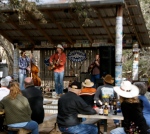 and honky tonks that go back to the nineteenth century and I’d like to visit them all; and the people are, for the most part, proud, big-hearted, warm and welcoming. That may not be a lot to go on, but that’s what I know about Texas.
and honky tonks that go back to the nineteenth century and I’d like to visit them all; and the people are, for the most part, proud, big-hearted, warm and welcoming. That may not be a lot to go on, but that’s what I know about Texas.
If you can startle me with an interesting fact about Texas, you might win a copy of Dances of the Heart. Go ahead and try. There’s plenty of facts out there. The facts I garnered above came from:
American History Revised: 200 Startling Facts. Morris Jr., Seymour. Broadway Books, New York.
The winner of a copy of Dances of the Heart is Hebby Roman. Many thanks to everyone who educated me on the great state of Texas!
Photos above : first two and the last, courtesy of Karen Casey Fitzjerrell; fifth, courtesy of Cristal Downing; remaining historical photos in public domain
***********************************************************************
Successful, workaholic author Carrie Bennett lives through her writing, but can’t succeed at writing a man into her life. Furthermore, her equally successful but cynical daughter, Paige, proves inconsolable after the death of her fiancé.
Hard-drinking rancher Ray Ryder can find humor in just about anything—except the loss of his oldest son. His younger son, Jake, recently returned from Iraq, now keeps a secret that could shatter his deceased brother’s good name.
On one sultry night in Texas, relationships blossom when the four meet, starting a series of events that move from the dancehalls of Hill Country to the beach parties of East Hampton, and from the penthouses of New York to the backstreets of a Mexican border town. But the hurts of the past are hard to leave behind, especially when old adversaries threaten the fragile ties that bind family to family…and lover to lover.
Available from February 4th wherever ebooks are sold, including:
The Wild Rose Press: http://www.wildrosepublishing.com/maincatalog_v151/index.php?main_page=index&manufacturers_id=991

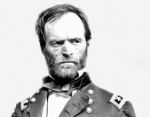
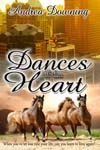


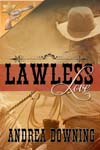












Well, kiddo, you pretty much nailed it. Nothing whatsoever to add. Come see me soon and we’ll make the honky tonk dance hall rounds. kcf
LikeLike
Ah, yes, living proof that not everything in Texas is big! But definitely proof of the big-hearted…
LikeLike
Well … you do know about the influx of Germans who settled in what was then the frontier districts of the Hill Country in the 1840s – and that German was the common language in three counties until the 1920s? And that the San Antonio Beethoven Mannerchor has the oldest 9-pin bowling alley in Texas, and the third-oldest in the US? And that Naeglin’s Bakery in New Braunfels has been in continuous operation since 1868. And that Gail Borden, who developed commercial canned condensed milk … was an early settler in Texas. He started a s a surveyor, and was the first to set out the plats for Galveston and Houston. He was also the publisher of a newspaper – the only one still in operation when Santa Anna’s army arrived in 1863. His newspaper published the first list of Alamo casualties. He kicked around in a number of enterprises, before developing the process to can condensed milk.
Think on this, the next time you see a can of condensed Borden milk on the grocery shelves.
LikeLike
Yeah, I did know about the Germans in TX, having traveled through Hill Country, but the Borden business is pretty dang interesting. To think that the smiling, happy Bordens cow is connected to Jim Bowie and Davy Crockett…
LikeLike
I was pretty boggled to discover that, myself. Borden spent a good few years in Texas, and then eventually returned to the Northeast US. Until the railways reached a good way into Texas after the Civil War, Texas was about the far end of nowhere. The most efficient way to get there was by steamship.
Another odd factoid – they shipped New England ice here – to Galveston and Indianola before the CW. It was an expensive imported luxury. Indianola had an extensive and very sturdy ice-storage warehouse which survived the hurricanes which destroyed the town in the 1870s and 80s. It was floated inland on a barge and became a private home, eventually.
LikeLike
That’s really interesting, Celia, especially about the hose. We take so much for granted these days, who’d thunk ice would be shipped?
LikeLike
I can’t surpass Celia’s information. But did you know that in the early days there were big lobsters in the gulf and the citizens fed them to the pigs? I learned that while enjoying the museum at Port Lavaca one winter while taking a respite from the snow and cold in Kansas. Totally useless information, but it’s all I got. 🙂
LikeLike
All I can think, Eunie, is what a waste!! I love lobster. But then again, one has to remember oysters were once a poor man’s dish. Times change!
LikeLike
Andi, amid all this seriously interesting talk about Texas, I can’t help worrying Texas might not be big enough to cope with you and Karen on a honky tonk spree…
LikeLike
LOL. Very Funny. But we’ll let you know–we’re hoping to do a book tour in the spring that should include a few honky tonks at least. I’m polishing my dancing boots.
LikeLike
Oh Paul, ye of little faith. Andi and my-own-self contain ourselves when necessary. LOL
LikeLike
We do?
LikeLike
See, that’s why I worry. One person’s containment is another person’s ….
Well you get the idea.
LikeLike
ROFL. I hope we can all get back to the subject of Texas now…
LikeLike
Yes, it was tragic about Galveston. It had this beautiful port, largest city in Texas and thriving, then wiped out by largest natural disaster in American History. I grew up on the border and the Gulf. Galveston was north of us, but we prided in tales of Jean Lafitte there. and then later on Pancho Villa used to raid my side of the border and when I was growing up the janitor of my elementary school was a man who rode with Pancho Villa. didn’t speak a word of English, but had this dignity about him and smart, played great accordion and raised kids that were valedictorians. i was brought up in Jim Crow Texas, but where I grew up we were integrated and the state looked the other way. and by the time I got to Texas A&M, it had also integrated without court orders to make it. it was time and everyone was looking to get past it so we just did it as they say. we used to raise ruby red grapefruit on our farm down on the border, it was the only place in the world that grew them at the time. we needed something. we were the only counties in Texas with no oil and it was the poorest area of the whole country. Stephen F Austin founded the first American colonies in Texas, his father Moses got the grants from Spain, but Mexico ruled by the time son Stephen formed the first colonies. everyone was Catholic in them and spoke Spanish. They tried hard to be good Mexican citizens. the later settles, the likes of Sam Houston and Davy Crockett went there not just for the land, but also to get away from the debacle and disgrace of the trail of tears where the five civilized tribes were forced off their land after assimilating and settling down. Crockett and Houston loved the Cherokee, of which i’m a descendent, and were so outraged by Andrew Jackson that that is one of the main reasons they left America to go to Texas. As you mentioned, Texas entered America on it’s terms, mutual terms, by treaty, one sovereign nation to another. in the treaty Texas was allowed to leave America any time it chose. but when it did to fight for the South, it was conquered, even though that right still exists and we flex our voices now and then when we get angry. we fly the Texas flag equally as high as the US flag, also allowed by that treaty. If you go to a Texas A&M football game to this day, that’s where you’ll see it, the Texas flag on one flag pole equally high as the US. and my alma mater, Texas A&M had more fight in World War II than any US institution. FDR came to our campus personally to thank us, as did Ike and Patton and Mac Arthur. and the fight song of my alma mater was written in the trenches of France during World War I as an Aggie Marine was fighting the Germans. That same fight song was the very first ever song played on the moon as one morning it was used to wake up and greet the astronauts that landed there, thanks to one of the chief scientists hired by NASA in Houston, having such an ambition for the likes of me to brag about.
LikeLike
Phew! Well, I’m speechless, Larry. What more can I say than thank you for all that history? And it sounds to me as if you have some good books in you about your childhood?
LikeLike
Andie, you’ve done a lot of research about Texas! For a New Yorker, ya done good, gal. 🙂
I need to go round up Larry. That man sounds like a treasure trove, and he’s not too far from me. (I’m in Galveston.)
Did you know about the Karankawa in Galveston? Rumor has it they were cannibals. Or that Jean Lafitte is thought to have been the first white person to set foot on Galveston? He founded a pirate stronghold here. Part of his fortified mansion, Maison Rouge, still stands near the port on the island’s north side. Local lore says part of his treasure remains buried somewhere on the island’s west end.
Galveston is also known as “a cemetery with a beach attached,” owing to the number of dearly departed who didn’t depart. The city is among the most haunted in the U.S., thanks to both the Civil War and the Great Storm of 1900.
I know you’re already aware that six of the ten bloodiest American feuds during the 1800s and early 1900s took place in Texas, because you visited my blog post about that the other day. 😉
Look up the Immortal 32 when you’re in the mood for a sad, yet inspiring, bit of Texas history. Those thirty-two men and boys were the only ones to respond to Travis’s urgent plea for help at the Alamo. They had to fight their way into the mission, only to die with the other defenders. (I wrote a post about them not too long ago, and I’ll be happy to send you the link, if you’d like it. 🙂 )
I could talk about Texas all day, but I’ll stop blathering on before someone gets out the hemp necktie. 😉
LikeLike
No hemp neckties, Kathleen–that’s a most excellent selection of information on the Lone Star State. I’d certainly like to get to Galveston one day (the song by Glen Campbell now running through my head…) And would like to know more about the Karankawa!
LikeLike
My favorite part of Texas is the Llano Estacado, or Staked Plains. That is the Panhandle region, the prairie. Up on the Llano, the weather is more like Kansas or Nebraska. It is not uncommon to have “blue northers” or big blizzards. Texas is a huge state and people often thing that the weather and terrain is the same state-wide.
LikeLike
Amy, some years ago I read a description of the trail rides north going through the Llano Estacado. I made up my mind to see it one day and thought, this year, I would have the chance. My daughter and I are planning a cross country road trip and the original route was going to take us there. But, alas, the trip was originally planned for May, me not being a good one for either crowds or heat, and when it had to be changed to June we had to re-route further north. I will get there one day! Thanks for reminding me and telling me more about it.
LikeLike
You do know a lot about Texas!!! However, have to give you my Latino flair on Texas. Did you know that the Tejanos (Texians of Mexican descent) had to wear special hatbands during their fight against the general Santa Anna at San Jacinto, so their fellow Texians wouldn’t take them for the enemy Mexicans and kill them? Or did you know that a Latino lady, De Leon, was the first person to start a campaign to save the Alamo from being turned into a hotel, not Clara Driscoll. Clara had more wealth and founded the Daughters of the Texas Republic, who administered the Alamo up until the last decade when the Park Service took it over. As a result, Clara got all the “good” press, not De Leon. De Leon had a plaque on the Alamo that was dedicated to her efforts, but it was taken down in the early twentieth century because of the Driscoll legend. But it was De Leon who first raised the hue and cry about losing our state’s most iconic landmark to retail development.
LikeLike
Hebby, that IS interesting! Certainly did not know about the hatbands. I guess different uniforms weren’t in use, as in the Civil War. And the DeLeon/Driscoll story is rather sad, really. I’m surprised no one has started a campaign to have the plaque to DeLeon reinstated. Thanks very much for that information–and I think perhaps you should lead the vanguard on that plaque!
LikeLike
Andi, I live in the Texas Panhandle on the Llano Estacado that Amy speaks about. I love it here where the land is rugged and the weather harsh and unpredictable at times. It was the last place in Texas to be settled. The Palo Duro Canyon (which is 15 miles from me) is known world wide. It’s the second largest to the Grand Canyon. One amazing fact…Texas once had its own embassy in London, England staffed with diplomats. The building is still there, emblazoned with the words The Texas Embassy, but it’s a restaurant now. Strangely, some militants thought it was real and bombed it two years ago when a writer friend of mine was there. Good luck with your book!
LikeLike
Hey Linda, as someone who lived in London for more years than I’ll admit to, I know the Texas Embassy Cantina very well though I never ate there. It had a reputation as a rip-off place for American tourists and has actually now closed. Not sure what’s in the building now, unfortunately. Thanks for that reminder, though, about the ‘Nation’ of Texas having an overseas embassy! And yes, I’ve heard about the beauty of that Palo Duro Canyon and intend to see it for myself one day.
LikeLiked by 1 person
I found all this fascinating but hoped to hear something about Lubbock TX. Western Writers of America will have their convetion there in June. So far I know about Mac Davis and Buddy Holly but that’s about it.
LikeLike
Lubbock does seem to turn up as the setting in a number of books, Irene, but I’m afraid I can’t personally enlighten you on the town. Maybe one of the WWW gang will stop by with some info…
LikeLike
Looking forward to reading your book. I call the Staked Plains near Amarillo and Palo Duro Canyon home as well. While there are many interesting historical tidbits on Texas, I want to clarify that it’s the absolute truth about our crazy weather. In one day you can witness foggy morning, followed by rain, lunch under a beautiful warm, sunny sky and drive home after work in a sleeting snow storm. And the people are just as interesting! Let me know if you pass through and I’ll introduce you to the most breath-taking sunset you’ll ever see in your life.
LikeLike
Thanks for the invitation, Natalie. I’ll look forward to that!
LikeLike
Great post tthankyou
LikeLike